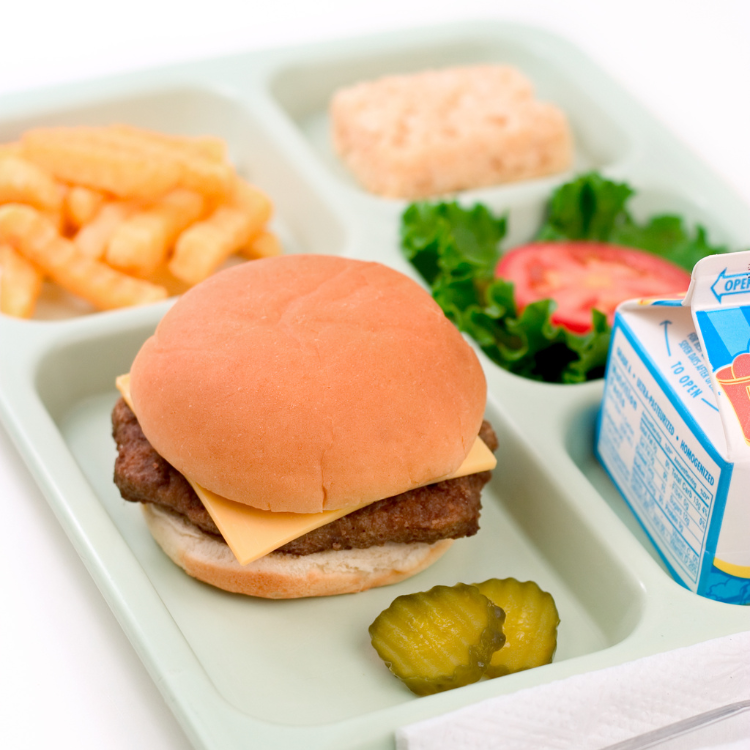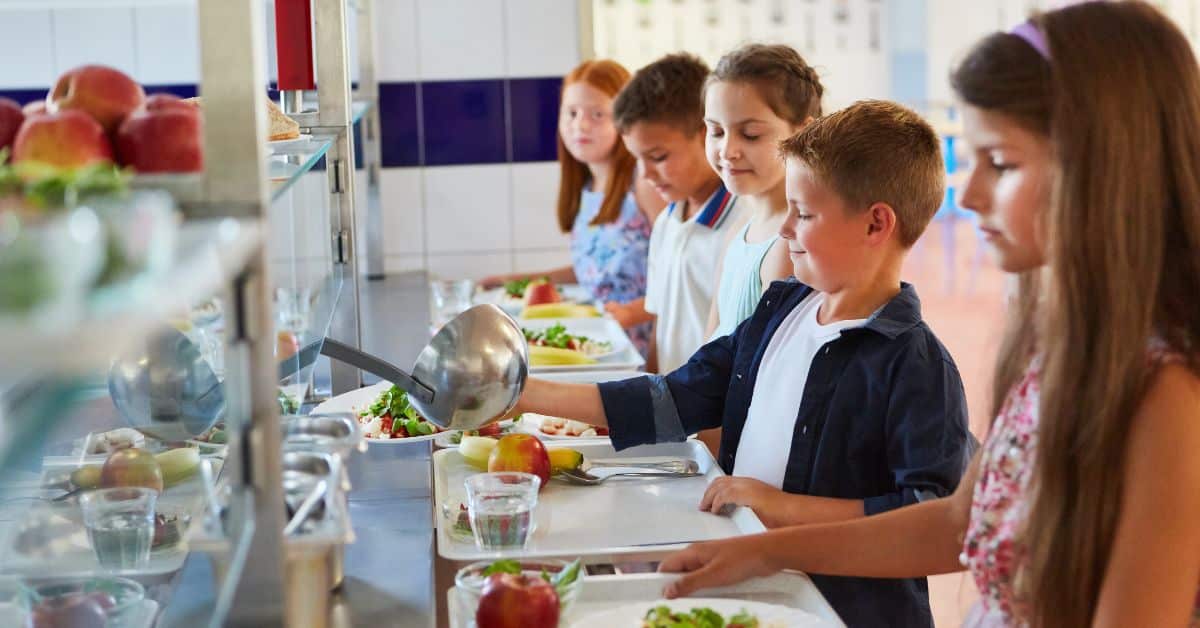

It’s that time again—back to school and, for many, back-to-school food, too! Unfortunately, it’s the school food that makes many parents cringe.
When we think of transforming school food, we may think of eliminating toaster pastries or decreasing the number of times pizza is served each week. Often, plant-powered kids pack a lunch, and their parents hope for minimal exposure to unhealthy foods. Either way, the consensus seems to be that no one likes school food. The question is, how do we change it?
It starts with a look at the big picture, which we might call the school food culture. This includes the school’s standards, norms, and social behavior, as well as the customs, beliefs, and habits of school staff and students regarding food available in the school setting. School food culture includes the unspoken yet demonstrated values that indicate which foods are more important and desirable and, conversely, which foods are useless and unwanted. It permeates, teaches, and reinforces nutritional values within the educational environment.
In practical terms, school food is not only what happens at mealtimes. It includes any instance when food is served or supplied on the school campus: class parties, food given as rewards, concession stands at sporting events, vending machines, bake sales, and fundraisers. Some people would even say that the snacks the school staff may have visible on their desks for their own consumption are also a part of the school food culture. No matter how we look at it, all these examples of food in schools send a message to the students about what kind of food we value and when and how we eat it.

The School Lunch Programs—those carefully planned meal breaks when all the students eat breakfast, lunch, and snacks—are perhaps the most notorious aspect of the food culture. The United States Department of Agriculture (USDA) oversees our National School Lunch Program. It defines which foods are allowed and how much food children are served during meals and snack times in more than 94,000 schools and residential child care institutions nationwide. In addition to setting nutrition standards for the general population, the USDA is also responsible for assuring our farmers have a solid market to sell their crops and animal products. These two purposes often conflict: representing the agriculture industry frequently involves encouraging the American people to eat unhealthy food. This is particularly damaging for children in schools.
Because most Americans eat the standard American diet (SAD) and the USDA tightly controls the meals provided in most schools, US school food programs typically reflect the SAD. School food cultures follow suit, usually supporting unhealthy foods with parties loaded with ultra-processed foods and sweets, small candies used as rewards, and team sporting events where they sell candy, buttered popcorn, pizza, sodas, and the like.
There are also national food recognition days for ice cream, donuts, cheese pizza, Pi (pie), Rice Krispies Treats, American pot pie, and chocolate milk. These are interlaced with Halloween, Thanksgiving, the winter holidays, St. Valentine’s Day, St. Patrick’s Day, Easter, and birthday parties. Sadly, this is the culture and environment in which most children spend most of the year.
Even with the best intentions and support, it is probably unrealistic to think that your child’s school will immediately remove all low-quality foods from the educational environment. However, parents, caregivers, and children can make a difference in the school food culture, even if that change may be gradual. Knowledge is power, and focusing on what we already know is the ideal place to begin. We know that adequate nutrition is imperative for children. We know that eating more whole plant foods helps kids resist illness, maintain a healthy weight, focus, think, and learn.

Transforming the school food culture starts with relationship building. Virtually all educators want students to be healthy and ready to learn, and that common interest is a good place to start the conversation. Here are a few steps you can take if you want healthy food to be the most significant part of your kid’s school food culture.
- Go to your child’s school and speak with the classroom teacher. Be friendly. Ask them how the school year has been going. Start a positive relationship. Ask if you can help implement a healthy snack plan for the kids. Maybe other parents would be willing to supply fruit or veggies for the kids once a month. Offer to help arrange it. Suggest non-food rewards instead of candies.
- Join the PTSA. Bring information on the importance of healthy food for the growth, development, and learning ability of children. Look for like-minded PTSA members or other parents who feel the same way you do. Start a committee to work on transforming the school food culture.
- Speak with the school principal. Keep in mind that most educators want children to be healthy and ready to learn. Assume that is true for the principal, too. Also, consider that the principal and other staff members may not know that processed foods can negatively affect the students’ ability to focus, learn and manage their emotions. Find out what challenges she faces in the school and ask how you could help her make healthy food a bigger part of the school food culture. For example, are there vending machines with soda, chips, and cakes? Find out what it would take to remove them from the school grounds.
- Are the team booster clubs selling low-quality, unhealthy fare at sporting events? See what inroads you can make to change the offerings. The goal is to make healthy options the default options when food is sold, even at fundraisers.
- Find out the name of the food services director for your school or school district. You may not be well received if you start off assuming you know everything there is to know about school lunch programs; it’s important that you are willing to learn. So, meet her with open heart and open mind. Ask her about the issues she faces in the lunchrooms. She likely has challenges with training, staffing, supply chains, and budgetary constraints, just like many other businesses have experienced in the last three years. Also, remember that dietary specialists are under unique pressures, and they are trying to do the best for the children they serve. Many schools do not even have fully equipped kitchens!
- Join the school’s wellness committee. Work with other committee members to write measurable, trackable health and wellness goals into the policies. Assure that school improvement plans contain specific language about making a healthy school food culture the new reality.
Making healthy food the easy choice will go a long way in supporting the students and staff now and in the future. Building a healthy food culture can start at school and spill into the community! That includes everywhere food is offered, from small class parties to large school events, both on the school campus and beyond.
You can find many helpful free resources for transforming school food on the internet. Search keywords “Transforming School Food.” The resources provided here are a good starting point. How you apply what you learn will depend on your values, ethics, and the school environment. Organizations that exclusively promote whole food, plant-based (WFPB) dietary lifestyles are indicated.
A word of caution: Several of the sites offer toolkits for school food transformation. Though most advocate for more plants and scratch cooking, some of their recipes may include animal products. Please be aware that some of the websites also have meat and dairy companies as sponsors. We denounce the use of animal products because of the impact on human, animal, and planetary health. However, we have included these websites in the list because their information on transforming school food is informative and could be valuable in changing a school food culture.
- PlantPure Communities (WFPB)
Click the button that says, “View All Products.” On the next page, scroll toward the bottom and select “Healthy Childhood Nutrition.” - HealthySchoolFood.org (WFPB)
- PCRM (WFPB)
- Food Revolution (WFPB)
- Chef Ann Foundation
- Action for Healthy Kids
- Whole Kids Foundation
- We Are Scratchworks
- Healthy Schools Campaign
- Ecoliteracy
- Hitchcock Farms
Copyright 2025 Center for Nutrition Studies. All rights reserved.
Deepen Your Knowledge With Our
Plant-Based Nutrition
Certificate
Plant-Based Nutrition Certificate
- 23,000+ students
- 100% online, learn at your own pace
- No prerequisites
- Continuing education credits









